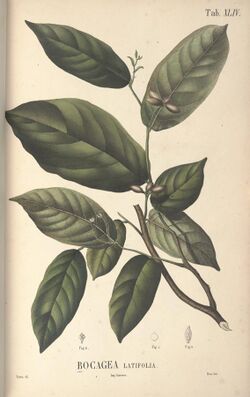Biology:Pseuduvaria latifolia
| Pseuduvaria latifolia | |
|---|---|

| |
| Botanical illustration of Pseuduvaria latifolia using the synonym Bocagea latifolia | |
| Scientific classification | |
| Kingdom: | Plantae |
| Clade: | Tracheophytes |
| Clade: | Angiosperms |
| Clade: | Magnoliids |
| Order: | Magnoliales |
| Family: | Annonaceae |
| Genus: | Pseuduvaria |
| Species: | P. latifolia
|
| Binomial name | |
| Pseuduvaria latifolia (Blume) Bakh.f.
| |
| Synonyms | |
|
Bocagea latifolia Blume | |
Pseuduvaria latifolia is a species of plant in the family Annonaceae.[1] It is native to Java.[2] Carl Ludwig Blume, the German botanists who first formally described the species using the synonym Bocagea latifolia, named it after its broad (latus in Latin) leaves (folium in Latin).[3][4]
Description
It is a tree reaching 10 meters in height. The young, dark brown to black branches are sparsely covered in lenticels. Its elliptical to oval, papery to slightly leathery leaves are 9.5-19 by 4-7 centimeters. The leaves have slightly heart-shaped bases and tapering tips, with the tapering portion 3-20 millimeters long. The leaves are hairless on their upper and lower surfaces. The leaves have 10-14 pairs of secondary veins emanating from their midribs. Its hairless petioles are 2-5 by 0.8-3 millimeters with a broad groove on their upper side. Its Inflorescences occur in clusters of 1-5 on branches, and are organized on slightly hairy peduncles that are 1.5-4 by 0.3-0.7 millimeters. Each inflorescence has up to 2 flowers. Each flower is on a slightly hairy pedicel that is 11-24 by 0.2-0.8 millimeters. The pedicels are organized on a rachis up to 5 millimeters long that have 2-6 bracts. The pedicels have a medial, slightly hairy bract that is 0.5-1 millimeters long. Its flowers are unisexual. Its flowers have 3 free, triangular sepals, that are 1.5-2 by 1.5-2 millimeters. The sepals are hairless on their upper surface, sparsely hairy on their lower surface, and hairy at their margins. Its 6 petals are arranged in two rows of 3. The pale yellow, oval, outer petals are 3-5 by 3-5.5 millimeters with hairless upper and sparsely hairy lower surfaces. The pale yellow, diamond-shaped inner petals have a 2-3.5 millimeter long claw at their base and a 5-9.5 by 2-5 millimeter blade. The inner petals have pointed bases and tips. The inner petals are hairless on their upper surfaces and densely hairy on their lower surfaces. The inner petals have a pair of elliptical, smooth, raised glands on their upper surface. Male flowers have up to 40-58 stamens that are 0.7-0.8 by 0.7-0.8 millimeters. Female flowers have 3-6 carpels that are 2.2-2.7 by 0.8-1.3 millimeters. Each carpel has up to 6 ovules arranged in two rows. The fruit occur in clusters of 3 arranged on slightly hairy peduncles that are 3-4 by 1-2 millimeters. The individual fruit are attached by slightly hairy pedicles that are 24-26 by 1.5 millimeters. The fruit are oval to elliptical and 18-21 by 12-14 millimeters. The fruit have a pointed tip 1 millimeter long. The fruit are smooth, and densely hairy.[5]
Reproductive biology
The pollen of P. latifolia is shed as permanent tetrads.[6]
Habitat and distribution
It has been observed growing in forests at elevations of 150 meters.[5]
References
- ↑ "Pseuduvaria latifolia (Blume) Bakh. f.". Species 2000. n.d.. https://www.catalogueoflife.org/data/taxon/4PFJP.
- ↑ "Pseuduvaria latifolia (Blume) Bakh.f.". The Trustees of the Royal Botanic Gardens, Kew. n.d.. https://powo.science.kew.org/taxon/urn:lsid:ipni.org:names:74952-1.
- ↑ Blume, C.L. (1830) (in Latin). Flora Javae nec non insularum adjacentium. 2. Brussels: J. Frank. pp. 89-90. https://www.biodiversitylibrary.org/item/103181.
- ↑ Stearn, William (2004). Botanical Latin. Portland, Ore. Newton Abbot: Timber Press David & Charles. ISBN 9780881926279.
- ↑ 5.0 5.1 Su, Yvonne C.F.; Saunders, Richard M.K. (2006). Monograph of Pseuduvaria (Annonaceae). Systematic Botany Monographs. 79. American Society of Plant Taxonomists. pp. 1–204.
- ↑ Su, Yvonne C. F.; Saunders, Richard M. K. (2003). "Pollen structure, tetrad cohesion and pollen-connecting threads in Pseuduvaria (Annonaceae)". Botanical Journal of the Linnean Society 143 (1): 69–78. doi:10.1046/j.1095-8339.2003.00204.x. ISSN 1095-8339.
Wikidata ☰ Q15365740 entry
 |

